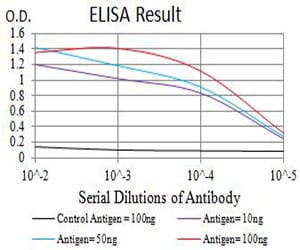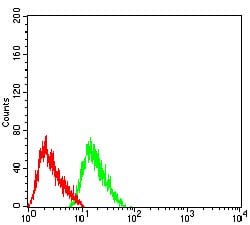

| WB | 咨询技术 | Human,Mouse,Rat |
| IF | 咨询技术 | Human,Mouse,Rat |
| IHC | 1/100-1/200 | Human,Mouse,Rat |
| ICC | 技术咨询 | Human,Mouse,Rat |
| FCM | 1/20-1/100 | Human,Mouse,Rat |
| Elisa | 咨询技术 | Human,Mouse,Rat |
| Aliases | EFNL3; nAChRB2 |
| Entrez GeneID | 1141 |
| clone | 2D12A2 |
| WB Predicted band size | 57kDa |
| Host/Isotype | Mouse IgG2a |
| Antibody Type | Primary antibody |
| Storage | Store at 4°C short term. Aliquot and store at -20°C long term. Avoid freeze/thaw cycles. |
| Species Reactivity | Human |
| Immunogen | Purified recombinant fragment of human CHRNB2 (AA: extra 26-233) expressed in E. Coli. |
| Formulation | Purified antibody in PBS with 0.05% sodium azide |
+ +
以下是关于FADD抗体的3-4条参考文献及其简要摘要:
---
1. **文献名称**:FADD, a novel death domain-containing protein, interacts with the death domain of Fas and initiates apoptosis
**作者**:Chinnaiyan AM, O’Rourke K, Tewari M, Dixit VM
**摘要**:该研究首次鉴定了FADD蛋白,证明其通过死亡结构域与Fas受体结合,并介导凋亡信号传递。研究利用FADD抗体进行免疫共沉淀和Western blot,揭示了FADD在凋亡通路中的核心作用。
2. **文献名称**:Regulation of FADD phosphorylation and cell death by mitogen-activated protein kinase signaling
**作者**:Zhang J, Winoto A
**摘要**:探讨MAPK信号通路对FADD磷酸化的调控及其对凋亡的影响,通过FADD抗体检测磷酸化状态,发现其与细胞存活/死亡的动态平衡相关。
3. **文献名称**:FADD is required for DR4- and DR5-mediated apoptosis through formation of the death-inducing signaling complex
**作者**:Kischkel FC, et al.
**摘要**:研究证实FADD是DR4/DR5死亡受体复合物的关键组分,使用FADD抗体阻断实验表明其参与TRAIL诱导的凋亡,为癌症治疗提供机制依据。
4. **文献名称**:Tissue-specific autoimmunity and immune dysregulation in FADD-deficient mice
**作者**:Tournier C, et al.
**摘要**:通过构建FADD缺陷小鼠模型,结合FADD抗体的组织染色分析,揭示FADD缺失导致T细胞异常活化及自身免疫表型,强调其在免疫稳态中的作用。
---
以上文献均涉及FADD抗体的实验应用(如Western blot、免疫共沉淀、组织染色等),并围绕FADD在凋亡信号、疾病机制及治疗中的功能展开。
FADD (Fas-associated protein with death domain) is an adaptor protein critical for mediating apoptotic signaling through death receptors in the extrinsic pathway. Structurally, it contains a C-terminal death domain (DD) that interacts with activated death receptors like Fas, TNF-R1. and TRAIL receptors, and an N-terminal death effector domain (DED) that recruits caspase-8/10 to form the death-inducing signaling complex (DISC). This assembly initiates caspase activation, leading to programmed cell death. FADD also participates in non-apoptotic processes, including cell proliferation and innate immunity, though its primary role remains apoptosis regulation.
FADD antibodies are essential tools for detecting FADD expression and studying its function. They are widely used in techniques like Western blotting, immunohistochemistry (IHC), and immunofluorescence (IF) to assess protein levels, localization, and interactions in cell lines, tissues, or experimental models. Researchers employ these antibodies to explore FADD's involvement in diseases such as cancer (where its dysregulation may promote resistance to apoptosis), autoimmune disorders, and neurodegenerative conditions. Specific FADD phosphorylation events (e.g., Ser194 in humans) are also analyzed to investigate post-translational modifications affecting its activity.
When using FADD antibodies, validating specificity via knockout controls or siRNA knockdown is crucial, as cross-reactivity with other DED-containing proteins may occur. Commercial antibodies vary in performance across applications, necessitating optimization based on experimental conditions. Reliable FADD detection enhances understanding of apoptosis mechanisms and therapeutic targeting of related pathways.
×